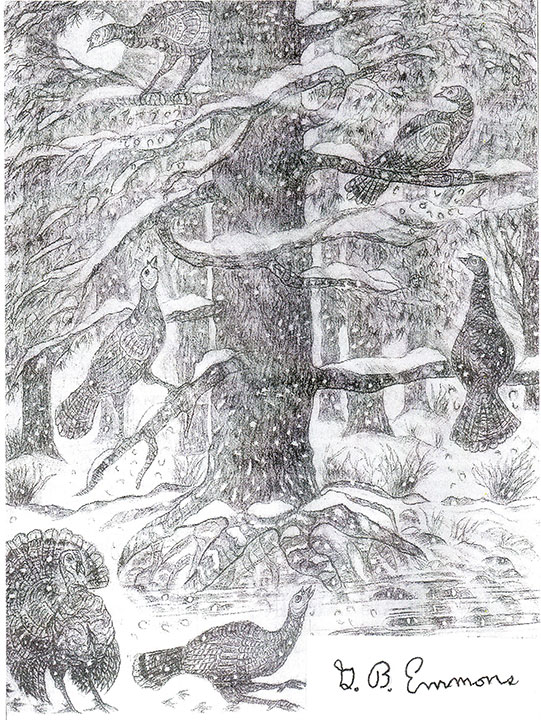Looking across Little Bay from my back porch window, the icy grip of winter seems to be breaking up after each rising sun and with the ebb and flow of daily tidal movement. The panorama overhead also comes to life on warming winds and whistling wings of waterfowl unfolding to drop into edges of liberated open waters. However, as a relatively new resident of Buzzards Bay, my weather expectations have proved to be consistently wrong.
I moved here after some twenty years of consistently similar winters past in high Appalachian elevations of the Berkshire Mountains of Western Massachusetts. Some years a blanket of snow covered the ground before winter even began until too long after it was over. Hibernation for cold- and warm-blooded creatures was always a survival command performance. And snow was still around for telltale tracks when they decided to come out and about. (My illustration is of a flock of Wild Turkeys going to roost for the night in a late February blizzard to take shelter in the upper branches of a tall white pine with the light of the full moon called the Snow Moon by the Algonquin.)
For the white-tailed deer also, the ground food was consistently covered, so they would gather for the winter under a canopy of thick conifer cover of cleared ground. This was known as a winter deer pen. After a long period of near-starvation, a doe could burn up most of her body fat, including the embryo of her unborn fawn. But if the winter is short and mild, a doe can often give birth to two and sometimes three fawns.
My monthly wildlife column and drawing for a local Berkshire paper for some twenty years was inspired by wildlife adapting to seasonal location. Some of them raised eyebrows of disbelief, such as documenting and illustrating mountain lion sightings passing through, almost unseen, coming down from the high ridges to visit the deer pens. Mountain lions in that area had been classified as extinct by state and federal authorities. It was almost believable, until my wife, Jan, saw one along the road a mile from our house.
After the first spring week of thawing temperature, a local mother bear would awaken from under a brush pile of a nearby swamp and make her usual spring neighborhood rounds. She would break down every bird feeder to feed two or three cubs making their first public outing. One day a cow moose casually strolled through the center of the small town, showing off a newborn calf, while they both grazed on the cleared athletic field behind Town Hall.
Meanwhile, back in our South Shore coastal environment, you may have read in the Old Farmer’s Almanac that if winter came in like a lamb, it could go out like a lion. This may be unpleasantly inconvenient for all of us, but critical for the habitat, sustenance, and reproduction of wildlife in late winter. I will share this progression toward spring with you in The Wandererin these following weeks.
By George B. Emmons
